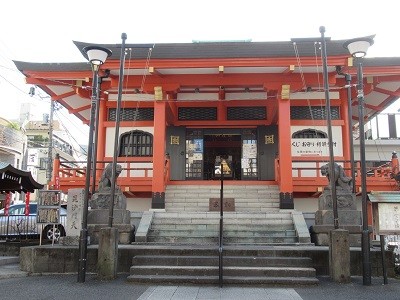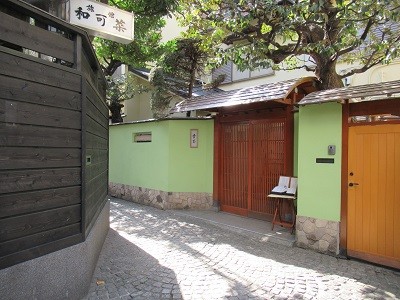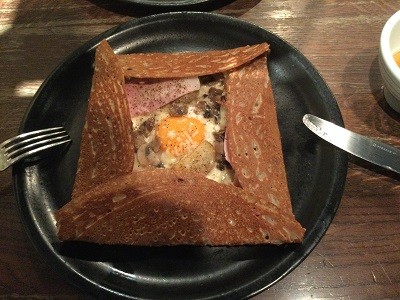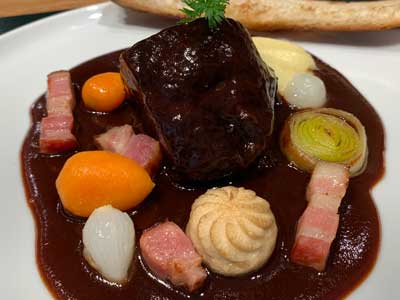Kagurazaka (神楽坂) in central Tokyo is one of the city’s nicest areas to just stroll around. It is known as one of Tokyo’s geisha districts. You can enjoy the atmosphere of the old town with narrow streets surrounded by black wooden walls. Kagurazaka is known for its many upscale restaurants that are hidden in the many alleyways. Getting lost in Kagurazaka’s backstreets is a great afternoon activity!


Meaning of Kagurazaka
Kagura (神楽) means ‘music which is played during a Shinto ritual’, and Saka (坂) means ‘slope’. It is said that you could hear the kagura music from the nearby Wakamiya-Hachiman Shrine. The music encourages people when they carry a portable shrine and walk up the slope during festivals. As you can imagine, some good festivals are held in this area throughout the year, the most noteworthy one being the summertime Kagurazaka Festival.
Geisha culture
The geisha is one of the cultural symbols of Japan. Geisha literally means ‘person of art’. Geisha attend dinners and they entertain customers with songs, playing musical instruments such as shamisen (three strings instrument like a guitar), dance, games, and conversation. So they have to practice hard to be good artists. Restaurants where you can order a geisha are called ryotei (料亭). If you go to Kyoto, they call it Ochaya which literally means ‘tea house’ because the geisha culture in Kyoto started from tea houses.
Dinner with geisha was very popular from the Edo period (17th – mid 19th century) until the early 20th century because there were not many other entertainment options in the evening at that time. But now, as there are many ways to enjoy the evening, the geisha culture has been diminishing year by year.
Geisha in Kagurazaka
Kagurazaka became a geisha district in the mid 19th century. Only 10 years later, the Tokugawa Shogunate came to an end and a new government and era started in Japan. The area used to be the living quarter of samurai warriors, but it changed into a business district quickly. The geisha culture developed with the town around it. In the 1930s, there were about 150 ryotei and 600 geisha. This included Taikomochi, a male geisha who assisted the female geisha with comical talk. But now, only 4 ryotei and about 20 geisha are still active in the area.
Narrow Streets
Some of Kagurazaka’s narrow streets have interesting names. Let’s have a look at them.
Geisha-Shindo: This is not the main street of Kagurazaka, so geisha used to use this road to go to the restaurants secretly, avoiding the crowds.
Kakurenbo-Yokocho: It literally means ‘the street of hide-and-seek’. Because there are many turns and bifurcations, even if you follow someone secretly, you will probably lose them.
Hyogo Yokocho: Hyogo means ‘arsenal’. In this street, there used to be many storages that held weapons. This is one of the most beautiful streets in the area.
Zenkokuji Temple
Zenkokuji (善國寺) is also called Bishamonten (毘沙門天) because it enshrines the statue of Bishamonten. It is one of the guardian deities who guard the four directions. Bishamonten keeps the north free from evil. Interestingly there are a pair of tigers at the entrance of the main hall. That is because Bishamonten was born in the year, month, date, and time of the tiger. The statue is normally hidden, and you can see it only on special occasions such as New Year’s Day and other festive occasions.


Japanese Restaurants
Yukimoto: Yukimoto is one of the four ryotei in Kagurazaka. Here, you can enjoy an elegant course dinner and you can order geisha, too. A dinner attended by geisha costs at least 15,000 JPY per person.
Shimakin: this is an Unagi or eel restaurant facing the main street. They started their business 150 years ago. They also serve course menus. You can order a Taikomochi to liven up your dinner.


French Restaurants
There are many high-end Japanese restaurants in the area, and there are also a lot of French restaurants. That is because the French language school ‘Institute Francais’ was established in Kagurazaka in 1952. It is said that they chose the place because Kagurazaka looked like Montmartre in Paris where you find a lot of slopes and stairs. So it made them feel right at home, and then, many French people came to live in this area.
Le Bretagne: They serve meals of the Bretagne region of France. Their main dish is ‘galette’, which is a crepe made of buckwheat. It is especially good to have galette with cider or sparkling apple wine.


Your Japan Tour
As seasoned Japan experts, we can help you create your perfect Japan tour including guides who can tell you all about the geisha culture and history of the area. And the guide can take you to the Kagurazaka area and show you the beautiful narrow streets. Contact us to start planning your unforgettable holiday to this fascinating country. Japan is full of once-in-a-lifetime experiences, culture, history, nature, and delicious food!
Access Information Kagurazaka
Access: There are two stations to go to Kagurazaka. One is Kagurazaka Station of Tokyo Metro Line. It is in the upper town. Another station is Iidabashi Station of JR and Tokyo Metro Line. It is in the lower town.